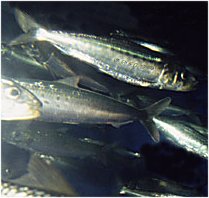 The Pilchard is a small pelagic fish that lives in the costal waters around New Zealand. They can be
found just about anywhere from rivers, creeks, inlets, esturies and bays. They are quite common in and around the Hauraki Gulf in the North, and in the Tasman Bay area in the south.
The Pilchard is a small pelagic fish that lives in the costal waters around New Zealand. They can be
found just about anywhere from rivers, creeks, inlets, esturies and bays. They are quite common in and around the Hauraki Gulf in the North, and in the Tasman Bay area in the south.
Surface schooling is more common during the summer months because they like the more open waters, but in the winter they prefer the deeper water inlets.
The pilchard is sometimes confused with the sprat. The Sprat may be distinguished by the position of the dorsal fin, being further along the back and the shorter plumper body shape. The pilchard are seldom found associateing with other fish, but are sometimes seen mixing with sprats and anchovy.
The pilchard has a slightly longer and more compressed body shape with a series of small spined plates along each side of the belly, but these are not as well developed as they are in the sprat. The front of the dorsal fin is situated at a point midway along the back, The ventral fins are placed on the belly directly below the middle of the dorsal fin, and the caudal fin is fork shaped. The lower jaw slightly longer than the upper jaw, and the pilchard has no teeth.
The pilchard like the sprat has numerous small scales covering the body.
The colour of this fish is varies slightly from dark blue to dark olive green on the top sides, with the lower parts being silver. There is also a row of small black spots running along the sides between the two different colours.
Pilchards are slightly longer than sprats, and grow to an average size of around 10-20cm (4-8) inches, but they can reach about 25cm (9¾") long.
In the nothern parts of the country the pilchard spawns all year round, but in the more southern waters they spawn only in the late spring and summer.
Like the sprats, the eggs float freely on or near the surface of the ocean, and drift with the currents until hatched out in the open sea.
Food is small planctonic crustaceans